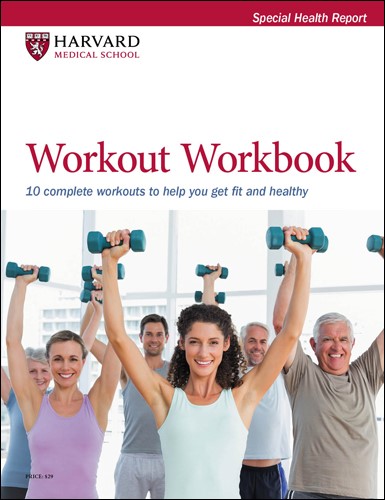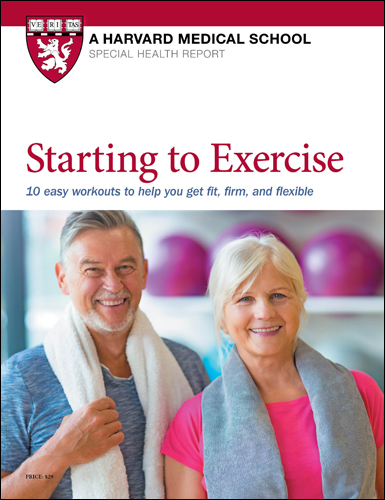Recent Articles

Medication side effects: What are your options?

Independent living with home care assistance: Balancing autonomy and support

Dialysis: What to expect from this life-changing — and lifesaving — treatment

The BEEP program: Keep your balance

Hoarding: What to know about this mental health disorder

21 spices for healthy holiday foods

Listeria: How to protect yourself from this common cause of food poisoning

Adult day care can benefit older adults and their caregivers

Digestive enzymes: How supplements like Lactaid and Beano can help with digestion

Can probiotics help calm inflammatory bowel disease?


Workout Workbook: 9 complete workouts to help you get fit and healthy
The numbers are shocking. Just two out of 10 American adults meet recommended levels of physical activity. Nearly three out of 10 Americans ages 6 and older admit they aren’t active at all, despite reams of research proving that exercise is a powerful preventive, and sometimes an antidote, for disability and illness. This Special Health Report, Workout Workbook: 10 complete workouts to help you get fit and healthy, features nine excellent workouts that will challenge your body and spirit in a variety of ways while warding off boredom.
Other Product Information
The numbers are shocking. Just three out of 10 American adults are active enough to stay healthy and fit, and nearly four out of 10 admit they aren’t active at all, despite reams of research proving that exercise is a powerful preventive, and sometimes an antidote, for disability and illness. Which side of this divide are you standing on — and why? Maybe you’re not sure what blend of exercise is best. Or perhaps you know exactly what you need to do, but your workouts have become so humdrum that it’s harder than ever to dig up the energy to do them. Do you want to jump-start your sputtering exercise program? Or are you stuck on a plateau and wishing you could kick it up to the next level?
This special report is just the ticket. The nine excellent workouts inside will challenge your body and spirit in a variety of ways while warding off boredom. Each workout includes step-by-step instructions and photographs for every exercise. And we’ve designed the exercises so that you can tailor each one to your fitness level. Is an exercise too hard? Try the easier option. Too easy? We tell you how to make it more challenging. So go ahead. Set your goals. Check our safety tips. Select one or more workouts you’d like to master. And mix it up every month to six weeks to stay motivated. Your body — and mind — will thank you.
Prepared by the editors of Harvard Health Publishing in consultation with Lauren E. Elson, MD
Physical Medicine and Rehabilitation Instructor, Harvard Medical School, and Fitness Consultant
Michele Stanten, Certified Fitness Instructor, 52 pages. (2020)
Six tips for safe strength training
Use the six tips below to be safe and make the best gains from your strength workouts.
1. Focus on form, not weight. Good form means aligning your body correctly and moving smoothly through an exercise. Poor form can prompt injuries and slow gains because you aren’t isolating muscles properly. “I often start people with very light weights because I want them to get their alignment and form right,” says master trainer Josie Gardiner. “It’s good to start off using light to moderate weight when learning an exercise routine.” Concentrate on performing slow, smooth lifts and equally controlled descents while isolating a muscle group. You isolate a muscle group by holding your body in a specific position while consciously contracting and releasing certain muscles.
2. Tempo, tempo. Control is very important. Tempo helps you stay in control rather than undercut gains through momentum. Sometimes switching speed—lower three counts, lift one count—is a useful technique for enhancing power. Follow the tempo specified in each exercise for better gains.
3. Breathe. Blood pressure rises if you hold your breath while performing strength exercises. Exhale as you work against gravity by lifting, pushing, or pulling; inhale as you release.
4. Keep challenging muscles. The right weight differs depending on the exercise. Choose a weight that tires the targeted muscle or muscles by the last two reps while still allowing you to maintain good form. If you can’t do the last two reps, choose a lighter weight. When it feels too easy to complete all the reps, challenge your muscles again by adding weight (roughly 1 to 2 pounds for arms, 2 to 5 pounds for legs); adding a set to your workout (up to three sets); or working out additional days per week (as long as you rest muscle groups 48 hours between strength workouts). If you add weight, remember that you should be able to do all the reps with good form and the targeted muscles should feel tired by the last two reps.
5. Practice regularly. Performing a complete upper- and lower-body strength workout two or three times a week is ideal.
6. Give muscles time off. Strenuous exercise like strength training causes tiny tears in muscle tissue. Muscles grow stronger as the tears knit up. Always allow at least 48 hours between sessions for muscle to recover. If you’re doing a split strength session, you might do upper body on Monday, lower body on Tuesday, upper body on Wednesday, lower body on Thursday, etc.
- Diving in
- Why work your body?
- How much time should you spend on exercise?
- Setting goals and motivating yourself
- Slimming down
- Carrot or stick?
- Setting your goals
- SPECIAL SECTION: Exercise 101
- Five components of fitness
- Terms to know
- The right stuff: Equipment for workouts
- Using the routines
- Posture, alignment, and angles
- Six tips for safe strength training
- Measuring gains
- Formal measures
- Other measures
- Try new trends
- Gym versus home
- Avoiding injury
- Safety first
- Posture and alignment: Striking the right pose
- 6 tips for effective strength training
- The workouts
- Key to the instructions
- Equipment used in the workouts
- Warm-up
- Home and travel workout
- Resistance band and tube workout
- Ball workout
- Mixed workout: Bosu, weights and medicine ball
- Core workout
- Split strength workout: Lower body
- Split strength workout: Upper body
- Power challenge workout
- Complex challenge workout
- Cool-down
- Resources
- Glossary
You might also be interested in…

Starting to Exercise
What can improve your mood, boost your ability to fend off infection, and lower your risk for heart disease, diabetes, high blood pressure, and colon cancer? The answer is regular exercise. It may seem too good to be true, but it's not. Hundreds of studies demonstrate that exercise helps you feel better and live longer. Starting to Exercise answers many important questions about physical activity. It will also help guide you through starting and maintaining an exercise program that suits your abilities and lifestyle.
Recent Articles

Medication side effects: What are your options?

Independent living with home care assistance: Balancing autonomy and support

Dialysis: What to expect from this life-changing — and lifesaving — treatment

The BEEP program: Keep your balance

Hoarding: What to know about this mental health disorder

21 spices for healthy holiday foods

Listeria: How to protect yourself from this common cause of food poisoning

Adult day care can benefit older adults and their caregivers

Digestive enzymes: How supplements like Lactaid and Beano can help with digestion

Can probiotics help calm inflammatory bowel disease?
Free Healthbeat Signup
Get the latest in health news delivered to your inbox!
Sign Up

